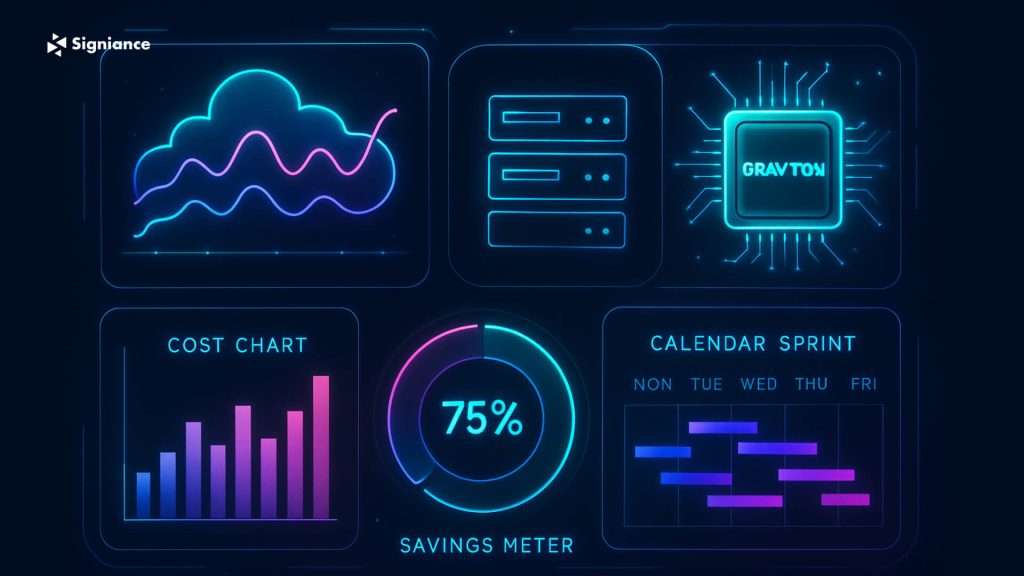Turn WAR findings into dollars saved with a prioritized plan that doesn’t slow delivery.

Why a 30‑day sprint
A Well‑Architected Review is a great mirror. It shows what’s healthy, what’s risky, and where money is silently leaking. But slides don’t save money. actions do. This 30‑day sprint turns that report into real, verifiable savings without freezing feature work.
The playbook is simple: start with quick wins (rightsizing and schedules), lock in predictable discounts (Savings Plans), improve price‑performance (Graviton), and use a single place to quantify and sequence everything.
Day 1–2: Set up the control tower
Goal: Centralize opportunities, set alerts, and create a single prioritized backlog.
Give spend an owner. Standardize tags (owner, environment, cost center, data class), set monthly budgets, and turn on cost anomaly alerts so surprises show up the same day. not at invoice time.
Aggregate savings ideas. Enable the cost optimization console across accounts. Pull in recommendations for idle resources, rightsizing, storage tiering, and commitments, each with an estimated monthly impact.
Make it sortable. Save views by account, region, and service so every team can see its “top 3 actions.” Export one shared backlog that includes estimated savings and effort.
Output: A ranked backlog with owners and expected monthly savings.
Day 3–7: Rightsize what exists
Goal: Quick wins with minimal code changes.
Resize and clean. Downshift over‑provisioned EC2 and database classes, switch gp2→gp3 for volumes, enable storage autoscaling where it’s safe, and delete anything idle (orphaned EBS, unused load balancers, forgotten snapshots).
Tier the cold stuff. Move stale objects to S3 IA/Glacier tiers with lifecycle rules.
Prove it. Take “before” and “after” snapshots so finance and engineering can see real savings on the next bill.
Metric: Estimated savings from rightsizing vs. realized savings after two weeks (track the variance).
Day 8–10: Schedules and elasticity
Goal: Stop paying for idle capacity.
Put non‑prod to sleep. Dev, test, and demo should power down at night and weekends. A simple schedule can cut 40–70% of that spend.
Scale to SLOs. For production, confirm autoscaling ramps down during off‑peak while keeping latency and error targets intact.
Metric: Percentage of non‑prod covered by schedules (aim for at least half sleeping nightly) and observed off‑peak reduction in production.
Day 11–15: Commitments done right. Savings Plans coverage
Goal: Cover the steady baseline, keep flexibility for burst.
Set the rule. Cover predictable compute with Savings Plans; keep experiments and spiky work on demand.
Pick the flavor. Use instance‑specific plans when families/regions are stable; choose compute plans for container/serverless flexibility.
Start small, roll forward. Size an initial purchase based on steady usage, then review coverage weekly. Stagger future purchases so nothing expires all at once. Add simple alerts for low utilization or expiring coverage.
Metric: Coverage and utilization of plans (healthy posture: baseline covered, utilization above 95%).
Day 16–20: Graviton for price‑performance
Goal: Reduce unit costs without sacrificing performance.
Find candidates. Web APIs, containerized services, CI runners, and compatible databases often move cleanly to ARM‑based Graviton.
Benchmark honestly. Compare versions head‑to‑head: p95 latency, throughput, and cost per request.
Roll out safely. Promote the wins behind canaries, then make “Graviton‑first” the default for new workloads where it fits.
Metric: Share of compute on Graviton and measured price‑performance gain per service (target 20%+ where adopted).
Day 21–25: Verify savings and prevent regressions
Goal: Close the loop and bake in guardrails.
Reconcile the math. Compare projected vs. actual savings and adjust assumptions. Celebrate wins; learn from misses.
Make it stick. Keep monthly budgets, anomaly alerts, and a 30‑minute “cost health” review on the calendar. Ensure new services inherit tags, schedules, and sane defaults automatically.
Metric: Gap between projected and realized savings, number of anomalies caught before invoice, and percentage of resources properly tagged.
Day 26–30: Scale the wins
Goal: Extend what worked; avoid over‑commitment.
Grow carefully. Increase Savings Plans as the baseline stabilizes; keep expiries staggered.
Line up the next wave. Queue more Graviton migrations, a second round of storage tiering, and any rightsizing still on the backlog.
Show the story. Publish a short “cost wins” note: actions taken, dollars saved, and what’s next. Culture follows transparency.
Metric: Month‑end savings vs. baseline, coverage/utilization trend for commitments, schedule adherence in non‑prod, and total share of compute now on Graviton.
Appendix: Checklists to move fast
- Tagging and ownership
- Required keys: owner, env, cost‑center, data‑class. Validate at deploy time.
Rightsizing worksheet
- Resource → current class → recommended class → dependency/risk → rollback plan → expected monthly savings.
- Savings Plans worksheet
- Coverage %, utilization %, lookback period, purchase/expiry dates, sharing rules, alert thresholds.
Graviton validation
- Image and libraries, performance targets, A/B results, rollout and rollback steps.
Saved views
- By account, service, and region; “top 3 actions” per team for weekly standups.
What day 30 should look like
- A published list of actions taken and verified savings, not just recommendations.
- Meaningful Savings Plans coverage with strong utilization.
- Non‑prod reliably asleep at night; production scaling based on real SLOs.
- The first services running on Graviton with clear price‑performance wins.
- A living backlog and a monthly review cadence that keep savings compounding.
Cost optimization isn’t a once‑a‑year scramble. it’s a muscle. With a focused 30‑day sprint and four core levers. rightsizing, schedules, commitments, and Graviton. teams can lower spend fast while improving performance and reliability. Treat this sprint as the first lap. Keep the cadence, and the savings will stack quarter after quarter.
